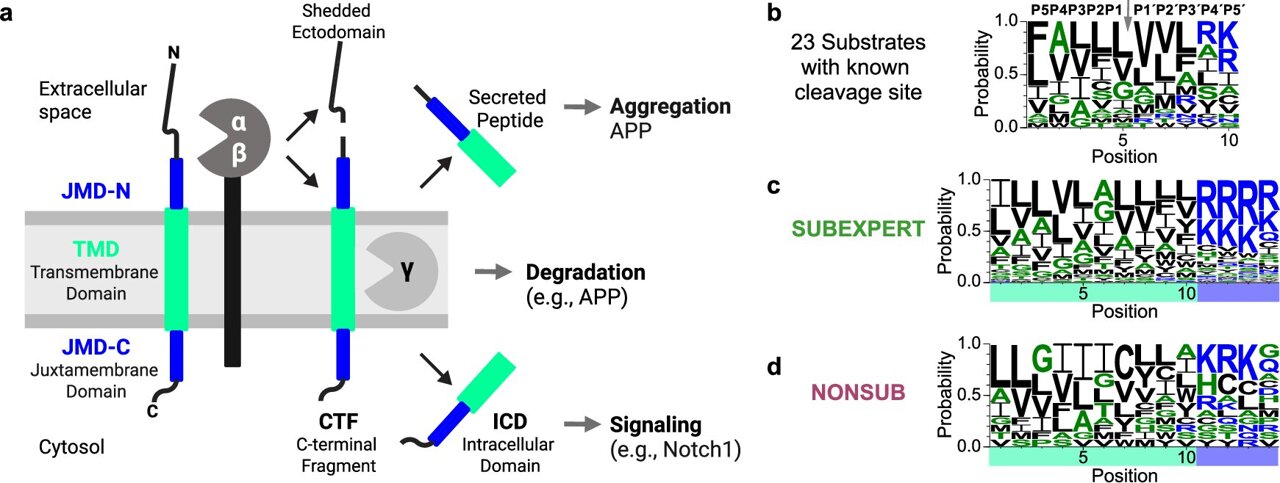
Researchers from DZNE, Ludwig-Maximilians-Universität München (LMU), and Technical University of Munich (TUM) have found that the enzyme "gamma-secretase"—implicated in Alzheimer's disease and cancer—selects its reaction partners according to a complex scheme of molecular features.
Subscribe to our newsletter for the latest science and technology news updates.
Their study, published in Nature Communications , introduces a methodology that decodes the enzyme's recognition logic by bridging biochemistry with explainable artificial intelligence (AI). This novel approach could help to better understand the role of gamma-secretase in diseases and aid drug development.
Gamma-secretase is an enzyme belonging to the category of "proteases" that plays a key role in Alzheimer's disease and cancer. It occurs in the membrane of numerous cells, including neurons, where—acting like a pair of scissors—it cleaves other membrane-bound proteins.
In the context of Alzheimer's disease, this happens with the so-called amyloid precursor protein. However, the enzyme is versatile: It has more than 150 known targets, also referred to as "substrates." Until now, the reason why gamma-secretase breaks down these particular molecules has been a mystery.
"Unlike most proteases, gamma-secretase does not recognize a clear sequence motif. This makes it difficult to predict its reaction partners using traditional computational methods," says Prof. Harald Steiner, leader of a research group at DZNE and LMU.
A collaborative effort
To overcome this obstacle, scientists from DZNE, LMU and TUM joined forces, bringing together an interdisciplinary team with expertise in computational biology, membrane biochemistry, and neurodegeneration research.
"We wanted to figure out what makes a protein a target of gamma-secretase. Instead of looking for patterns in the protein sequence, we developed a novel AI-based method that we call Comparative Physicochemical Profiling, or CPP for short. Using this approach, we analyzed the physical and chemical properties of known substrates in order to find hidden similarities," explains Dr. Stephan Breimann, who shares first-authorship of the current publication.
"Our methodology provides what is called explainable AI. It not only enables predictions about targets, but also helps to understand the logic behind them."
Dynamic structures
The current findings show that substrates of gamma-secretase share a distinct physicochemical signature near the cleavage site. Besides a local helical structure, this includes the potential to adopt alternative conformations when the enzyme binds to the substrate. These dynamic properties appear essential for molecular recognition within the special environment of a cell's membrane.
"This is a significant feature, although it is not the only difference from non-substrates. As we found, substrates of gamma-secretase are defined by the sum of a whole range of physicochemical properties," says Breimann.
Through this novel approach, 160 proteins were identified as potential substrates. None of these had previously been associated with gamma-secretase. Eleven of these proteins, including some involved in immune regulation and cancer, have already been experimentally validated as substrates in the current study.
Outlook
Due to the enzyme's presence in the cell membrane—where pathological processes can occur—the current findings could help to improve understanding the role of gamma-secretase in diseases. However, the researchers emphasize that the impact of their work extends beyond this particular enzyme.
"The CPP framework can be adapted to study other proteases and receptor systems, providing a powerful tool for understanding molecular recognition in health and disease," says Steiner. "Looking ahead, we hope that our approach can contribute to the design of drugs with greater specificity and fewer side effects."
More information: Stephan Breimann et al., Charting γ-secretase substrates by explainable AI, Nature Communications (2025). DOI: 10.1038/s41467-025-60638-z
Provided by German Center for Neurodegenerative Diseases
This story was originally published on Medical Xpress .






0 komentar:
Posting Komentar